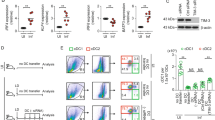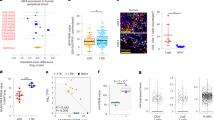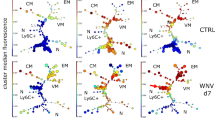Abstract
Immunity to infection with intracellular pathogens is regulated by interleukin 12 (IL-12), which mediates protective T helper type 1 (TH1) responses, or IL-4, which induces TH2 cells and susceptibility. Paradoxically, we show here that when present during the initial activation of dendritic cells (DCs) by infectious agents, IL-4 instructed DCs to produce IL-12 and promote TH1 development. This TH1 response established resistance to Leishmania major in susceptible BALB/c mice. When present later, during the period of T cell priming, IL-4 induced TH2 differentiation and progressive leishmaniasis in resistant mice. Because immune responses developed via the consecutive activation of DCs and then T cells, the contrasting effects of IL-4 on DC development and T cell differentiation led to immune responses that had opposing functional phenotypes.
This is a preview of subscription content, access via your institution
Access options
Subscribe to this journal
Receive 12 print issues and online access
$209.00 per year
only $17.42 per issue
Buy this article
- Purchase on Springer Link
- Instant access to full article PDF
Prices may be subject to local taxes which are calculated during checkout








Similar content being viewed by others
References
Fearon, D. T. & Locksley, R. M. The instructive role of innate immunity in the acquired immune response. Science 272, 50–53 (1996).
Abbas, A. K., Murphy, K. M. & Sher, A. Functional diversity of helper T lymphocytes. Nature 383, 787–793 (1996).
Paul, W. E. & Seder, R. A. Lymphocyte responses and cytokines. Cell 76, 241–251 (1994).
Reiner, S. L. & Locksley, R. M. The regulation of immunity to Leishmania major. Annu. Rev. Immunol. 13, 151–177 (1995).
Heinzel, F. P., Schoenhaut, D. S., Rerko, R. M., Rosser, L. E. & Gately, M. K. Recombinant interleukin 12 cures mice infected with Leishmania major. J. Exp. Med. 177, 1505–1509 (1993).
Sypek, J. P. et al. Resolution of cutaneous leishmaniasis: interleukin 12 initiates a protective T helper type 1 immune response. J. Exp. Med. 177, 1797–802 (1993).
Afonso, L. C. et al. The adjuvant effect of interleukin-12 in a vaccine against Leishmania major. Science 263, 235–237 (1994).
O'Garra, A. Cytokines induce the development of functionally heterogeneous T helper cell subsets. Immunity 8, 275–283 (1998).
Sadick, M. D. et al. Cure of murine leishmaniasis with anti-interleukin 4 monoclonal antibody. Evidence for a T cell-dependent, interferon γ-independent mechanism. J. Exp. Med. 171, 115–127 (1990).
Yamamura, M. et al. Defining protective responses to pathogens: cytokine profiles in leprosy lesions. Science 254, 277–279 (1991).
Racke, M. K. et al. Cytokine-induced immune deviation as a therapy for inflammatory autoimmune disease. J. Exp. Med. 180, 1961–1966 (1994).
Launois, P. et al. IL-4 rapidly produced by Vβ4Vα8 CD4+ T cells instructs Th2 development and susceptibility to Leishmania major in BALB/c mice. Immunity 6, 541–549 (1997).
Kopf, M. et al. IL-4-deficient Balb/c mice resist infection with Leishmania major. J. Exp. Med. 184, 1127–1136 (1996).
Liblau, R. S., Singer, S. M. & McDevitt, H. O. Th1 and Th2 CD4+ T cells in the pathogenesis of organ-specific autoimmune diseases. Immunol. Today 16, 34–38 (1995).
Rocken, M., Racke, M. & Shevach, E. M. IL-4-induced immune deviation as antigen-specific therapy for inflammatory autoimmune disease. Immunol. Today 17, 225–231 (1996).
Mosmann, T. R. & Sad, S. The expanding universe of T-cell subsets: Th1, Th2 and more. Immunol. Today 17, 138–146 (1996).
Romagnani, S. Lymphokine production by human T cells in disease states. Annu. Rev. Immunol. 12, 227–257 (1994).
King, C. et al. Interleukin-4 acts at the locus of the antigen-presenting dendritic cell to counter-regulate cytotoxic CD8+ T-cell responses. Nature Med. 7, 206–214 (2001).
Erb, K. J. et al. Constitutive expression of interleukin (IL)-4 in vivo causes autoimmune-type disorders in mice. J. Exp. Med. 185, 329–339 (1997).
Noben-Trauth, N., Kropf, P. & Muller, I. Susceptibility to Leishmania major infection in interleukin-4-deficient mice. Science 271, 987–990 (1996).
Mencacci, A. et al. Endogenous interleukin 4 is required for development of protective CD4+ T helper type 1 cell responses to Candida albicans. J. Exp. Med. 187, 307–317 (1998).
Schuler, T., Qin, Z., Ibe, S., Noben-Trauth, N. & Blankenstein, T. T helper cell type 1-associated and cytotoxic T lymphocyte-mediated tumor immunity is impaired in interleukin 4-deficient mice. J. Exp. Med. 189, 803–810 (1999).
Bagley, J., Sawada, T., Wu, Y. & Iacomini, J. A critical role for interleukin 4 in activating alloreactive CD4 T cells. Nature Immunol. 1, 257–261 (2000).
Salerno, A., Dieli, F., Sireci, G., Bellavia, A. & Asherson, G. L. Interleukin-4 is a critical cytokine in contact sensitivity. Immunology 84, 404–409 (1995).
Traidl, C., Jugert, F., Krieg, T., Merk, H. & Hunzelmann, N. Inhibition of allergic contact dermatitis to DNCB but not to oxazolone in interleukin-4-deficient mice. J. Invest. Dermatol. 112, 476–482 (1999).
Yokozeki, H. et al. Signal transducer and activator of transcription 6 is essential in the induction of contact hypersensitivity. J. Exp. Med. 191, 995–1004 (2000).
Radu, D. L., Noben-Trauth, N., Hu-Li, J., Paul, W. E. & Bona, C. A. A targeted mutation in the IL-4Rα gene protects mice against autoimmune diabetes. Proc. Natl Acad. Sci. USA 97, 12700–12704 (2000).
Golumbek, P. T. et al. Treatment of established renal cancer by tumor cells engineered to secrete interleukin-4. Science 254, 713–716 (1991).
Tepper, R. I., Pattengale, P. K. & Leder, P. Murine interleukin-4 displays potent anti-tumor activity in vivo. Cell 57, 503–512 (1989).
Kalinski, P. et al. IL-4 is a mediator of IL-12p70 induction by human Th2 cells: reversal of polarized Th2 phenotype by dendritic cells. J. Immunol. 165, 1877–1881 (2000).
Hochrein, H. et al. Interleukin (IL)-4 is a major regulatory cytokine governing bioactive IL-12 production by mouse and human dendritic cells. J. Exp. Med. 192, 823–834 (2000).
Ebner, S. et al. Production of IL-12 by human monocyte-derived dendritic cells is optimal when the stimulus is given at the onset of maturation, and is further enhanced by IL-4. J. Immunol. 166, 633–641 (2001).
Le Gros, G., Ben-Sasson, S. Z., Seder, R., Finkelman, F. D. & Paul, W. E. Generation of interleukin 4 (IL-4)-producing cells in vivo and in vitro: IL-2 and IL-4 are required for in vitro generation of IL-4- producing cells. J. Exp. Med. 172, 921–929 (1990).
Bradley, L. M., Yoshimoto, K. & Swain, S. L. The cytokines IL-4, IFN-γ, and IL-12 regulate the development of subsets of memory effector helper T cells in vitro. J. Immunol. 155, 1713–1724 (1995).
Rissoan, M. C. et al. Reciprocal control of T helper cell and dendritic cell differentiation. Science 283, 1183–1186 (1999).
Moser, M. & Murphy, K. M. Dendritic cell regulation of TH1-TH2 development. Nature Immunol. 1, 199–205 (2000).
Moll, H., Fuchs, H., Blank, C. & Rollinghoff, M. Langerhans cells transport Leishmania major from the infected skin to the draining lymph node for presentation to antigen-specific T cells. Eur. J. Immunol. 23, 1595–1601 (1993).
Diefenbach, A., Schindler, H., Rollinghoff, M., Yokoyama, W. M. & Bogdan, C. Requirement for type 2 NO synthase for IL-12 signaling in innate immunity. Science 284, 951–955 (1999).
Reiner, S. L., Zheng, S., Corry, D. B. & Locksley, R. M. Constructing polycompetitor cDNAs for quantitative PCR. J. Immunol. Meth. 165, 37–46 (1993).
Zimmermann, S. et al. CpG oligodeoxynucleotides trigger protective and curative Th1 responses in lethal murine leishmaniasis. J. Immunol. 160, 3627–3630 (1998).
Himmelrich, H. et al. In BALB/c mice, IL-4 production during the initial phase of infection with Leishmania major is necessary and sufficient to instruct Th2 cell development resulting in progressive disease. J. Immunol. 164, 4819–4825 (2000).
Julia, V., Rassoulzadegan, M. & Glaichenhaus, N. Resistance to Leishmania major induced by tolerance to a single antigen. Science 274, 421–423 (1996).
Carter, K. C., Gallagher, G., Baillie, A. J. & Alexander, J. The induction of protective immunity to Leishmania major in the BALB/c mouse by interleukin 4 treatment. Eur. J. Immunol. 19, 779–782 (1989).
Koch, F. et al. High level IL-12 production by murine dendritic cells: upregulation via MHC class II and CD40 molecules and downregulation by IL-4 and IL-10. J. Exp. Med. 184, 741–746 (1996).
Munder, M., Eichmann, K. & Modolell, M. Alternative metabolic states in murine macrophages reflected by the nitric oxide synthase/arginase balance: competitive regulation by CD4+ T cells correlates with Th1/Th2 phenotype. J. Immunol. 160, 5347–5354 (1998).
Levine, A. D. et al. High level expression and refolding of mouse interleukin 4 synthesized in Escherichia coli. J. Biol. Chem. 270, 7445–7452 (1995).
Kalinski, P., Hilkens, C. M., Wierenga, E. A. & Kapsenberg, M. L. T-cell priming by type-1and type-2 polarized dendritic cells: the concept of a third signal. Immunol. Today 20, 561–567 (1999).
Egeter, O., Mocikat, R., Ghoreschi, K., Dieckmann, A. & Rocken, M. Eradication of disseminated lymphomas with CpG-DNA activated T helper type 1 cells from nontransgenic mice. Cancer Res. 60, 1515–1520 (2000).
Kacha, A. K., Fallarino, F., Markiewicz, M. A. & Gajewski, T. F. Cutting edge: spontaneous rejection of poorly immunogenic P1.HTR tumors by Stat6-deficient mice. J. Immunol. 165, 6024–6028 (2000).
Ramanathan, S. et al. Recombinant IL-4 aggravates experimental autoimmune uveoretinitis in rats. J. Immunol. 157, 2209–2215 (1996).
Fort, M. et al. IL-4 exacerbates disease in a Th1 cell transfer model of colitis. J. Immunol. 166, 2793–2800 (2001).
Biedermann, T. et al. Reversal of established delayed type hypersensitivity reactions following therapy with IL-4 or antigen-specific Th2 cells. Eur. J. Immunol. 31, 1582–1591 (2001).
Banchereau, J. & Steinman, R. M. Dendritic cells and the control of immunity. Nature 392, 245–252 (1998).
Lutz, M. B. et al. An advanced culture method for generating large quantities of highly pure dendritic cells from mouse bone marrow. J. Immunol. Meth. 223, 77–92 (1999).
Favre, N. & Erb, P. Use of the CTL44 cell line, a derivative of CTL/L cells, to identify and quantify mouse interleukin-4 by bioassay. J. Immunol. Meth. 164, 213–220 (1993).
Acknowledgements
We thank W. E. Paul, E. M. Shevach (Laboratory of Immunology, NIAID, NIH), G. Riethmüller and T. Brocker (Department of Immunology, Munich) for helpful discussions and critically reading the manuscript and B. von Restorff for technical assistance. Supported by the Deutsche Forschungsgemeinschaft RO 764/8-1 and 676/1, SFB 217 and SFB 456, the Wilhelm Sander-Stiftung (97.041.2) and the Swiss National Science Fdt.
Author information
Authors and Affiliations
Corresponding authors
Rights and permissions
About this article
Cite this article
Biedermann, T., Zimmermann, S., Himmelrich, H. et al. IL-4 instructs TH1 responses and resistance to Leishmania major in susceptible BALB/c mice. Nat Immunol 2, 1054–1060 (2001). https://doi.org/10.1038/ni725
Received:
Accepted:
Published:
Issue Date:
DOI: https://doi.org/10.1038/ni725
This article is cited by
-
Centrin-deficient Leishmania mexicana confers protection against Old World visceral leishmaniasis
npj Vaccines (2022)
-
Centrin-deficient Leishmania mexicana confers protection against New World cutaneous leishmaniasis
npj Vaccines (2022)
-
Exogenous IL-13 exacerbates Leishmania major infection and abrogates acquired immunity to re-infection
Parasitology Research (2022)
-
Potential biomarkers of immune protection in human leishmaniasis
Medical Microbiology and Immunology (2021)
-
Leishmaniasis immunopathology—impact on design and use of vaccines, diagnostics and drugs
Seminars in Immunopathology (2020)



